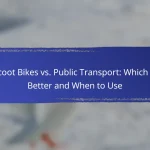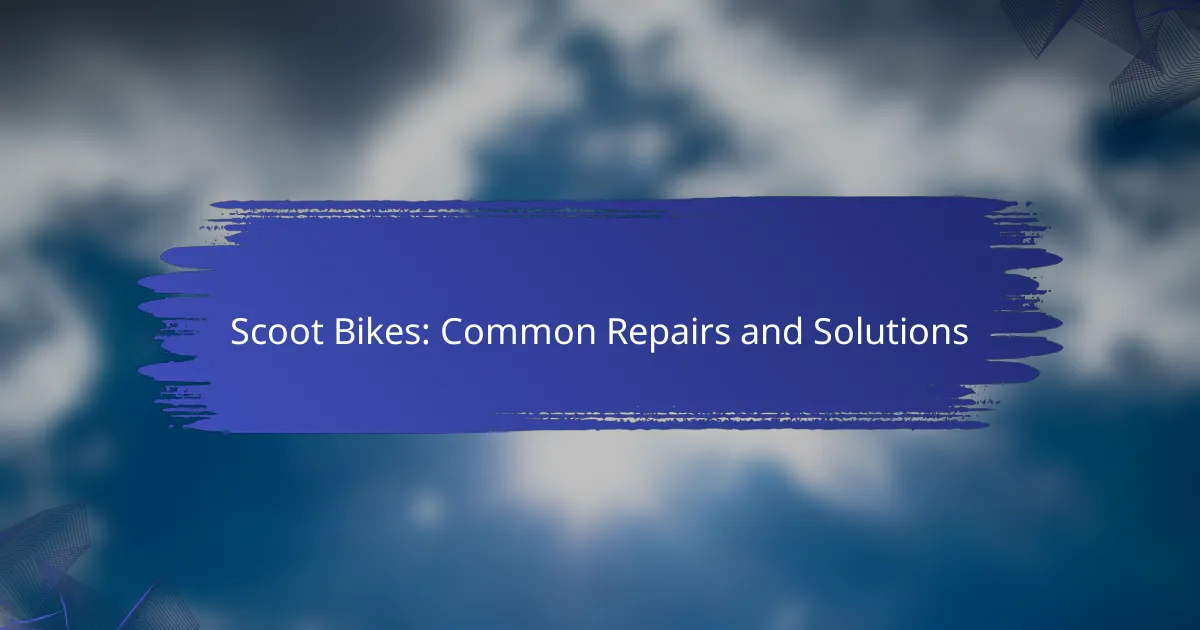Scoot Bikes, like any other mode of transportation, require regular maintenance and occasional repairs to ensure optimal performance and safety. Common issues include fixing punctured tires, adjusting brakes, replacing chains, troubleshooting batteries, and aligning handlebars. By addressing these repairs promptly, riders can enhance their safety and extend the lifespan of their bikes.

What are common repairs for Scoot Bikes?
Common repairs for Scoot Bikes include fixing punctured tires, adjusting brakes, replacing chains, troubleshooting batteries, and aligning handlebars. Addressing these issues promptly can enhance safety and prolong the bike’s lifespan.
Punctured tire repair
Punctured tires are a frequent issue for Scoot Bikes, often caused by sharp objects on the road. To repair a punctured tire, first remove the wheel from the bike, then locate the puncture and patch it using a tire repair kit.
Consider replacing the inner tube if the damage is extensive. Regularly check tire pressure and inspect for wear to prevent future punctures.
Brake adjustment
Brake adjustment is crucial for safe riding. If brakes feel loose or unresponsive, check the brake pads and cables for wear. Adjust the tension on the cables to ensure the pads make proper contact with the wheel rims.
It’s advisable to test brakes after adjustments to confirm they engage smoothly and effectively. Regular maintenance can help avoid brake failure.
Chain replacement
A worn or damaged chain can lead to poor performance and potential damage to other components. To replace a chain, first remove the old chain using a chain tool, then measure the new chain to ensure it fits your bike’s specifications.
Lubricate the new chain after installation to ensure smooth operation. Inspect the chain regularly for signs of wear to determine when replacement is necessary.
Battery troubleshooting
Battery issues can hinder the performance of electric Scoot Bikes. If the bike fails to start, check the battery connections for corrosion or looseness. Ensure the battery is charged; a fully charged battery typically lasts several hours of use.
If problems persist, consider testing the battery with a multimeter or replacing it if it fails to hold a charge. Regular maintenance of the battery terminals can prevent future issues.
Handlebar alignment
Misaligned handlebars can affect steering and comfort. To align handlebars, loosen the stem bolts and adjust the handlebars to the desired position, ensuring they are straight with the front wheel.
Tighten the bolts securely after adjustment. Regularly check handlebar alignment, especially after transporting the bike or hitting obstacles, to maintain optimal control.
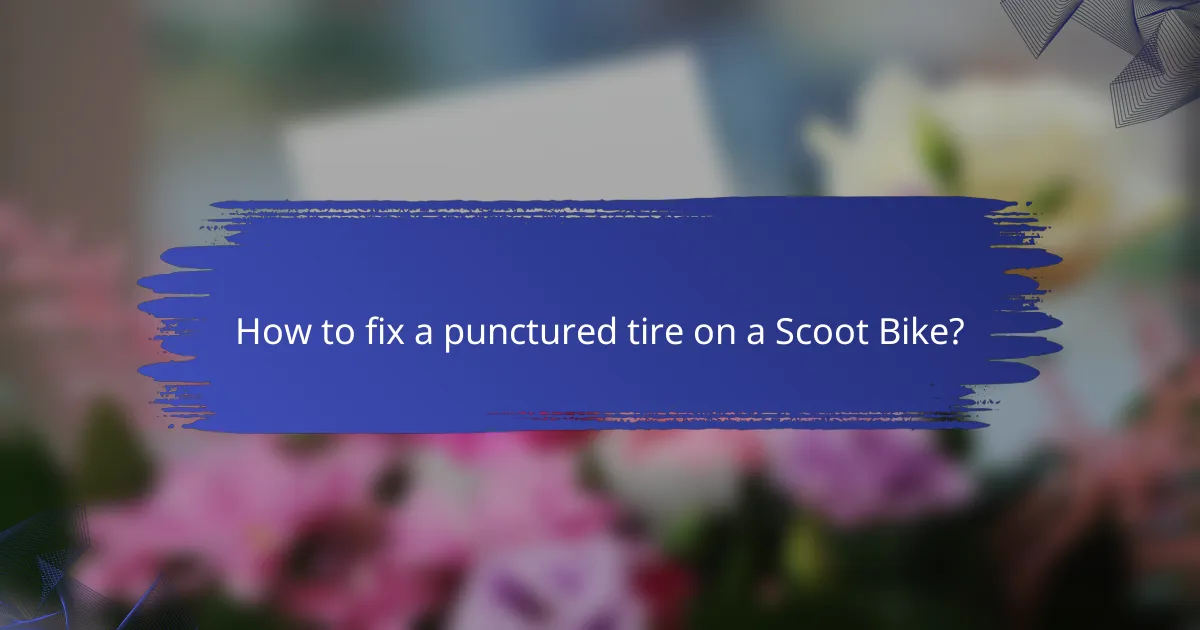
How to fix a punctured tire on a Scoot Bike?
To fix a punctured tire on a Scoot Bike, you need to remove the wheel, assess the damage, and either patch or replace the inner tube. This process can be straightforward with the right tools and a bit of patience.
Remove the wheel
Start by flipping the Scoot Bike upside down or placing it on a stable surface to access the wheel easily. Use a wrench to loosen the axle nuts or quick-release lever, depending on your bike’s design.
Once the nuts or lever are removed, carefully lift the wheel out of the frame. Be cautious not to damage the brake components during this process. If your bike has disc brakes, ensure the rotor does not get bent while removing the wheel.
Patch or replace the inner tube
After removing the wheel, take off the tire to access the inner tube. Inspect the tube for punctures or damage; if the hole is small, you can use a patch kit to seal it. Clean the area around the puncture, apply adhesive, and place the patch firmly over the hole.
If the damage is extensive or the tube is old, replacing it may be more effective. Purchase a new inner tube that matches the size of your tire, typically marked on the sidewall. Inflate the new tube slightly before installing it back into the tire to prevent pinching during reassembly.

What are the signs of brake issues on Scoot Bikes?
Signs of brake issues on Scoot Bikes include unusual noises and a noticeable decrease in stopping power. Addressing these problems promptly is crucial for safety and performance.
Squeaking or grinding noise
Squeaking or grinding noises when applying the brakes indicate potential wear on the brake pads or rotors. These sounds often suggest that the pads are either too thin or contaminated with debris, which can lead to reduced braking efficiency.
If you hear these noises, inspect the brake pads for wear and consider replacing them if they are below the recommended thickness. Regular maintenance can help prevent these issues from escalating.
Reduced stopping power
Reduced stopping power is a clear sign that your Scoot Bike’s brakes may need attention. This could be due to worn brake pads, air in the brake lines, or issues with the brake calipers.
To assess stopping power, perform a simple test by applying the brakes at a low speed. If the bike takes longer to stop than usual, check the brake components and consider bleeding the brake lines or replacing the pads. Regular checks can help maintain optimal braking performance.
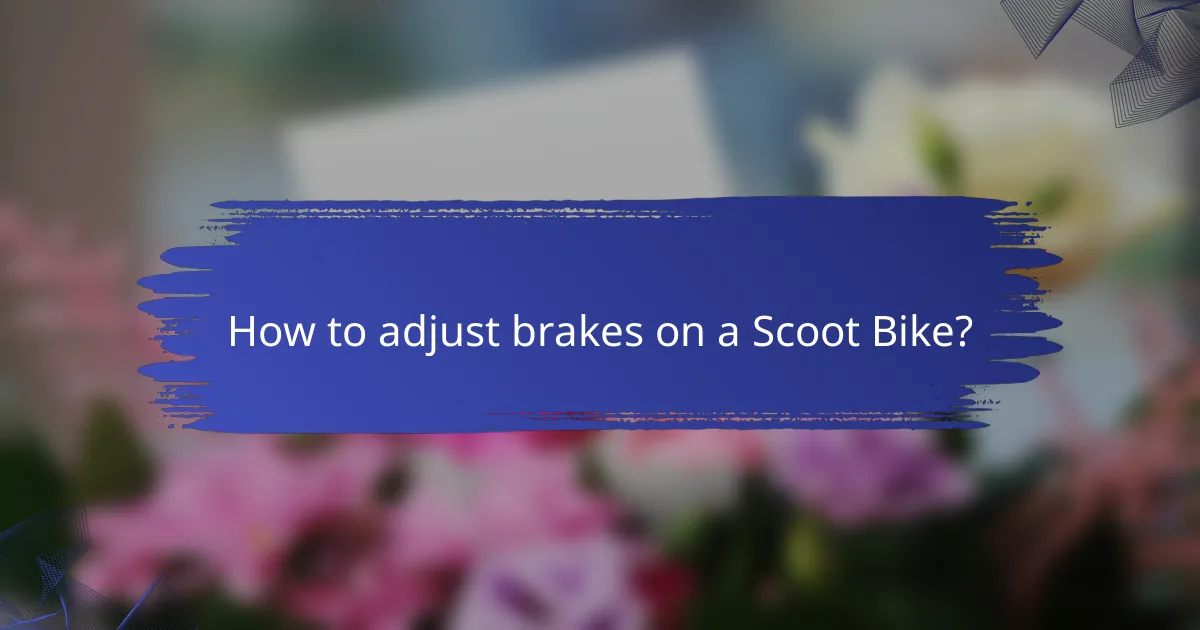
How to adjust brakes on a Scoot Bike?
Adjusting the brakes on a Scoot Bike is essential for safe riding. Proper brake adjustment ensures that the bike stops effectively and responds to the rider’s commands.
Loosen brake cable
To begin adjusting the brakes, you need to loosen the brake cable. Locate the cable adjuster on the brake lever or near the brake caliper, and turn it counterclockwise to release tension. This will allow you to reposition the brake pads and align them correctly.
Be cautious not to loosen the cable too much, as this can lead to ineffective braking. A good rule of thumb is to keep enough tension so that the brake lever feels firm when pulled.
Align brake pads
After loosening the brake cable, align the brake pads with the rim of the wheel. The pads should contact the rim evenly when the brake lever is pulled. Adjust the position of the pads by sliding them along their mounting brackets until they are properly aligned.
Check that there is a small gap between the pads and the rim when the brakes are not engaged. This gap should be around 1-2 mm to prevent rubbing while ensuring effective braking when needed.

What are common chain problems in Scoot Bikes?
Common chain problems in Scoot Bikes include chain slipping and a rusty chain. These issues can affect the bike’s performance and safety, so addressing them promptly is essential for a smooth ride.
Chain slipping
Chain slipping occurs when the chain fails to engage properly with the gears, causing it to skip or jump during pedaling. This can happen due to wear on the chain or sprockets, improper tension, or misalignment.
To fix chain slipping, first check the chain tension and adjust it if necessary. If the chain or sprockets show signs of wear, consider replacing them. Regular maintenance, such as cleaning and lubricating the chain, can help prevent this issue.
Rusty chain
A rusty chain can lead to poor performance and increased wear on the bike’s components. Rust typically forms due to exposure to moisture and lack of lubrication, which can cause the chain to seize or break.
To address a rusty chain, clean it thoroughly with a degreaser and a brush, then apply a suitable lubricant. If the rust is extensive and affects the chain’s integrity, replacement may be necessary. Regularly inspecting and maintaining the chain can help prevent rust buildup and extend its lifespan.
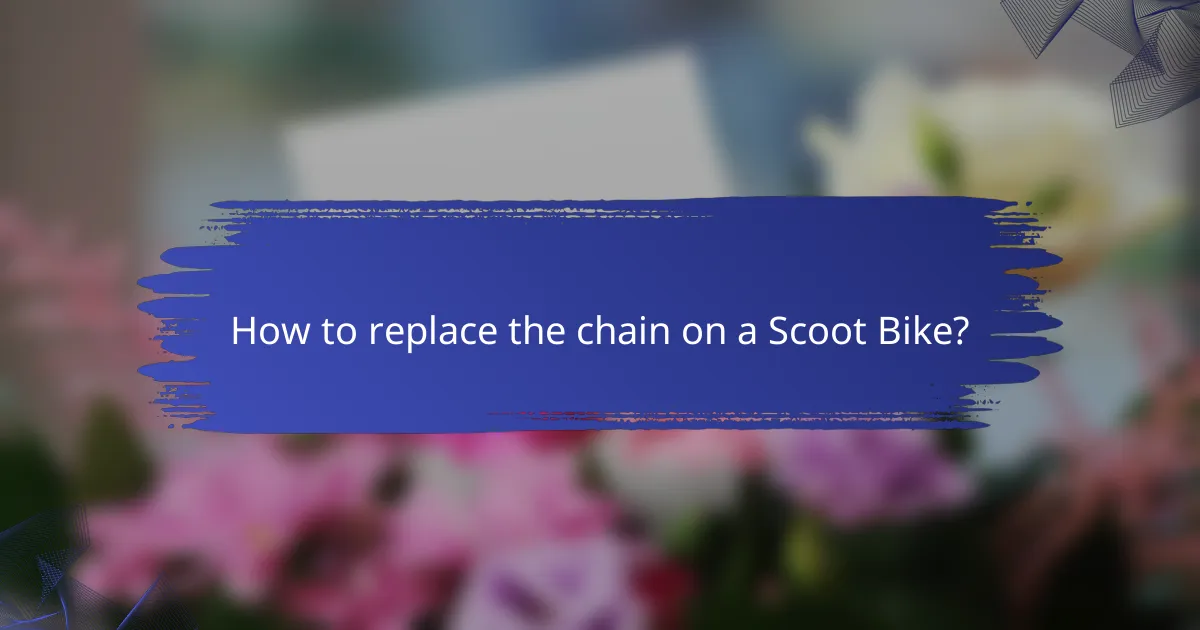
How to replace the chain on a Scoot Bike?
Replacing the chain on a Scoot Bike is a straightforward process that ensures smooth operation and extends the bike’s lifespan. Regular maintenance, including chain replacement, is essential for optimal performance and safety.
Remove the old chain
To remove the old chain, first, shift the bike into the smallest gear to relieve tension. Use a chain tool to push out the pin connecting the chain links, or if your chain has a quick link, simply disconnect it by hand.
Inspect the chain for wear and check the sprockets for any damage. If the chain shows significant wear, it’s advisable to replace both the chain and the sprockets to maintain performance.
Install the new chain
Begin by measuring the new chain against the old one to ensure the correct length. Use the same method to attach the new chain, either by pushing in a pin or reconnecting a quick link. Make sure the chain runs smoothly over the sprockets.
After installation, check the chain tension and adjust it if necessary. A properly tensioned chain will enhance performance and prevent premature wear. Regularly lubricate the chain after installation to keep it in good condition.
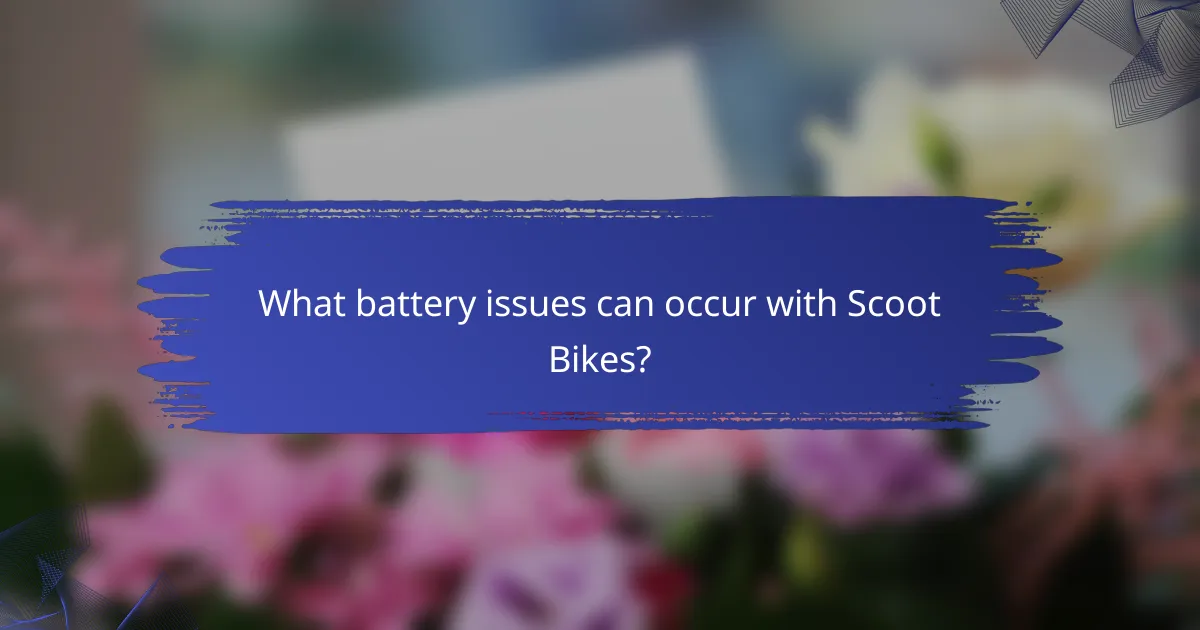
What battery issues can occur with Scoot Bikes?
Battery issues with Scoot Bikes can range from insufficient charge to complete failure. Understanding these problems can help users maintain their bikes effectively and avoid unexpected breakdowns.
Insufficient Charge
Insufficient charge is a common issue that can occur if the battery is not fully charged before use. Users should ensure that the battery is charged for the recommended duration, typically several hours, to achieve optimal performance.
To avoid running out of power during rides, it’s advisable to check the battery level regularly. If the battery frequently runs low, it may indicate that it needs replacement or servicing.
Battery Swelling
Battery swelling can happen due to overheating or overcharging, which may compromise the battery’s integrity. If a battery appears swollen, it should not be used, as it poses safety risks.
In such cases, users should immediately stop using the bike and consult a professional for battery inspection and replacement. Regular monitoring of battery temperature during charging can help prevent this issue.
Short Battery Life
Short battery life can be a frustrating problem, often caused by age or frequent deep discharges. Most batteries have a lifespan of a few hundred charge cycles, after which their capacity diminishes significantly.
To extend battery life, users should avoid letting the battery drain completely before recharging and store the bike in a cool, dry place. If the battery life drops below acceptable levels, consider replacing it with a new one.
Charging Port Issues
Charging port issues can arise from dirt or damage, preventing the battery from charging properly. Regularly inspect the charging port for debris and ensure it is clean before connecting the charger.
If problems persist, users should check the charger for functionality or consult a technician. Proper care of the charging port can help maintain consistent charging performance.





